Full Length Research Paper
ABSTRACT
Biodiversity offset practices often focus solely on securing ecological validity, despite biodiversity providing various human benefits such as ecosystem services (ES); the use of which is often lost by both the development project and the offset itself. In this paper, a framework is suggested to rationally examine the compensatory measures for ES use losses and tested with actual offset cases in developing countries, focusing on endangered coral ecosystems. In the framework, we first evaluate the necessity of compensatory measures for the losses of coral ES (CES) uses then suggest the restoration measures of CES uses instead of provisions for livelihood supports. The restoration measures include the provision of alternative sites and improvements to reduce the environmental load of the uses. The framework revealed that the necessity of compensation measures and the suitable restoration measure are varied depending on the original location and type of the CES uses, even within small areas. Together with optimum offset site selection, restriction of the destructive CES uses, integrating existing community-based resource management schemes, these careful considerations of CES in biodiversity offset provides hint that enable local people to achieving a balance between conservation and use. However, state of CES uses and corals should be monitored to ensure the framework effect. We further discuss the condition to apply this framework.
Key words: Biodiversity offset, coral, ecosystem service, restoration, developing country.
INTRODUCTION
Biodiversity offsets (offsetting) are the measurable conservation outcomes from actions taken to compensate for the residual adverse impacts of development projects on biodiversity, after taking prevention and mitigation measures (BBOP, 2012). The goal of offsetting is to reduce the net loss of biodiversity to at least zero, that is, to achieve “no net loss” (Bull et al., 2013; Ledec and Johnson, 2016). However, it is acknowledged that offsetting has various issues, such as the uncertainty of the offset achievement, poor arrangement of long-term monitoring, insufficient evaluation of the offsetting impact on biodiversity value for humans, and the physical distance of the prospective beneficiaries of offsetting to the recovery site (Maron et al., 2016; Grimm and Köppel, 2019; Souza et al., 2021). The most fundamental issue of offsetting is the tradeoff between conservation and use; the uses are predominantly supplied by healthy ecosystems well conserved, however, such ecosystem is degraded with the increasing uses (Moreno-Mateos et al., 2015; Sonter et al., 2020). These issues become failure risks of offsetting unless proper considerations are taken.
In developing countries, particularly within rural areas, these issues are more serious. This is because local livelihoods often rely largely on natural resources (Bidaud et al., 2017; BBOP, 2012). However, many offset practices focus only on securing ecological validity (Gelcich et al., 2017). Therefore, international aid organizations have recently requested that the social aspects of offset practices also be considered (BBOP, 2012; Ledec and Johnson, 2016; Jacob et al., 2016). The benefits provided by nature are generally called ecosystem services (ES).
In the long term, offsetting can restore ES loss via ecosystem recovery, if the offset site is located proximally to the impacted area (Agar et al., 2019; Ledec and Johnson, 2016). However, the current offset policy lacks evidence ensuring the offset’s potential for ecological restoration (Maron et al., 2012). This is an uncertainty of the offsetting and is caused in part by the poor arrangement of long-term monitoring, which means that the restoration of ES loss is also uncertain (Jossefson et al., 2021). In addition, since a traditional impact assessment lacks explicit guidance, an ES may be qualitatively evaluated as an item such as land use, habitat and land planning, but such evaluations may also miss some ESs (Honrado et al., 2013) and less considered biodiversity value for human beings (Souza et al., 2021). In contrast, during the offsetting period, additional ES losses often occur as natural areas acquired as offset sites and certain uses of the ESs are restricted for offset site management (Ledec and Johnson, 2016; Bidaud et al., 2017). Moreover, ES losses induced by development projects will remain for a certain period until “no net loss” is successfully achieved (Bullock et al., 2011). Due to these circumstances, many local livelihoods could be threatened by ES losses. While, the pattern of ES use varies from site to site depending on demographic dynamics (Honrado et al., 2013). Therefore, such ES losses may not be serious depending on the location.
To supplement the lack of guidance available when considering ES offsetting, ES considerations for the establishment and management of protected areas (PA) could be used as a reference, as both PAs and offset sites ultimately have the same objectives (Benabou, 2014; Bidaud et al., 2017). Furthermore, a number of studies have scientifically and practically demonstrated the key points required for successful PA establishment and management (Edgar et al., 2014; Kelleher, 1999; Lester et al., 2009; Leverington et al., 2010). However, we must pay further attention to the considerations of ES for offsetting because the uses of ES (ES uses), which are affected by both development projects and offsetting, can be concentrated elsewhere, causing conflicts and further resource degradation (Bidaud et al., 2017). Thus, developing a methodology by which to address cumulative ES losses and consequent social problems is a key challenge in offset planning (Jacob et al., 2016).
In recent studies, to tackle the above-mentioned issues, an approach was proposed that selects offset sites using three criteria: (1) those with higher restorability to mitigate uncertainty; (2) those with a lower human dependency on ES to mitigate trade-offs and reduce additional loss and conflict; and (3) those with easy access for users to mitigate the physical distance (Takeda et al., 2020). However, this approach will not solve all offsetting issues; the additional and remaining losses should be supplemented through compensatory measures such as livelihood support or monetary payments, and/or any other suitable approaches.
In conventional practices of development projects and PA management, various livelihood supports have often been provided as compensatory measures against losses or restrictions on ES (Munthali and Mughogho, 1992; Sievanen et al., 2005; Triet, 2010); however, in many cases, the effects of these supports have been questioned or criticized as ineffective (Ireland, 2004; Wright et al., 2015; Roe et al., 2017; Lowe et al., 2019). Furthermore, because of insufficient monitoring data for social changes, many cases have failed to evaluate the effects (Roe et al., 2017; Wicander and Coad, 2018). Given the financial difficulties of developing countries, compensatory measures should be effective. Therefore, the restoration of lost ES uses might be more realistic as a compensation measure.
Coral reefs have developed from the tropics to the subtropics and sustain a rich biodiversity in many countries (Moberg and Rönnbäck, 2003; Yeemin et al., 2006). Most coral reefs are in developing countries within the tropical zone (Birkeland, 1997; Gomez, 1997). However, those coral reefs under threat due to recent development activities and/or urbanization (Cesar et al., 2003; Wilkinson, 2008), as well as rising sea temperatures, and the acidification of seawater (Burke et al., 2001). To address these situations, several coral propagation techniques, such as simple transplantation, transplantation of nursery-raised corals, and electro-stimulation have been implemented on a trial basis (Barton et al., 2015; Jacob et al., 2018). However, fundamental challenges to propagation have also been identified, such as the difficulty in selecting sites that meet physical and biological conditions, the removal of anthropogenic stressors, and the measurement of restoration success and long-term monitoring (Bayraktarov et al., 2016). Furthermore, there are more cautious opinions that state there are no established techniques of propagation (Precht et al., 2005; Edwards and Gomez, 2007; Hein et al., 2017). For this reason, offsetting through the establishment and management of PAs is likely to be more realistic as a countermeasure, at least in the mitigation of the adverse impacts of development projects on coral in developing countries. However, a marine environment presents unique challenges such as environmental complexity and difficulty in the governance of resource management, and therefore, a detailed study on how these challenges can be dealt with through an offset practice is expected (Niner et al., 2017, Jacob et al., 2020).
The objective of this paper is to develop a framework that efficiently compensates for the losses of coral ES (CES) uses induced by both development projects and offsetting. The framework rationally evaluates the necessity of compensation and places a priority on restoring the lost CES uses by examining the social situation surrounding ES uses in and around the affected area. the framework was applied to an actual coral offsetting case and discussed its advantages and the possibilities for sustainable CES uses.
METHODOLOGY
Approach
The mitigation hierarchy against the loss of ecosystems and ES uses and the study approaches by which to consider compensatory measures to loss are shown in Figure 1. Since the loss of ES uses may not be serious, the necessity of compensatory measures for each ES use was first evaluated. Once a certain necessity is recognized, restoration measures will be suggested.
Framework
The framework used to examine compensatory measures is described in Figure 2. This framework ultimately aims to consider two items that coincide with the study approach: (A) the evaluation of necessity for compensatory measures; and (B) the suggestion of restoration measures. Item (B) can be further codified into three subcategories; (1) suggestion of measures to improve the CES uses so as not to impact corals; (2) the identification of alternative sites that can accommodate impacted CES uses; and (3) the evaluation of the necessity for livelihood support.
To evaluate the necessity for compensatory measures, we estimated how much each CES use contributes to livelihoods (analysis “1”), how the restriction of CES uses is perceived (analysis “2”), and how much CES use has been impacted by the development project and will be impacted by the offsetting (analysis “3”). Since some ES, such as cultural services, are difficult to replace with a monetary value (Bullock et al., 2011; Calvet et al., 2015; Moreno-Mateos et al., 2015), the contributions of CES uses were estimated using two types of data: The level of original engagement in the CES activities (data “a”) and the purpose of the CES activities (data “b”). The perception to the restriction is estimated using direct data about the acceptance of the restrictions and its reasons (data “c”). The impacts of the development project and offsetting on CES uses are estimated from the CES activities continuation status (data “d”), reasons for the discontinuation (data “e”), and the inconvenience felt when performing the CES activities (data “f”).
If specific CES uses have a high need for compensation, the content of the restoration measures is examined for those uses. To examine these, the necessary conditions for CES uses (analysis “4”) are estimated from four types of data: Reasons for the discontinuation (data “e”), inconvenience felt when performing CES activities (data “f”), sites for the current CES activities (data “g”), and necessary conditions required to perform the CES activities (data “h”).
Eventually, the necessity for compensation measures and the restoration measures are comprehensively examined for each CES activity and original site uses. If reasonable restoration measures are not found, the necessity of the livelihood supports is evaluated.

Application to a coral offset case
This framework was applied to a coral offsetting case induced by a wharf development project in the Republic of Vanuatu. The idea of offsetting in this case is that offset coral losses by creating a new PA at a site where mechanically damaged corals exist in a Community Conservation Area (CCA) that is under registration process. The outputs of the framework are expected to be incorporated into the CCA management plan, and the restriction of activities will be newly set, specifically for the offsetting on top of the CCA regulations, to secure the additionality of the offsetting. Two (2) offset sites, named Ifira East and Fatumaru in Port Vila Bay (where the wharf project site is located), were officially selected as the offset sites from four candidate sites (Figure 3) after analysis of their advantages and disadvantages (Takeda et al., 2020). Those advantages and disadvantages were evaluated based on the following: (1) levels of dependency on CES, (2) restorability, and (3) accessibility for CES users and/or managers. Ifira East is advantageous because of its high restorability, while Fatumaru is advantageous in terms of both its restorability and lower dependency. These offset sites were declared by the executing agency to the residents of Port Vila City after a series of consultations with stakeholders, including the primary CES users and the resource managers of Port Vila Bay.
Surveys
A preliminary survey was conducted in October 2017 before construction of wharf was completed, in which random interviews were held on the street around the local market, schools, and residential areas of Por-Vila City. The aim was to test the question items to be used for the main survey and to roughly grasp the CES activities performed around Port Vila Bay. This interview style was adopted as the required information did not depend on the locality, and with the aim to hear opinions directly from various people. Response alternatives for questions were predetermined based on the census report of Port Vila City (McEvoy et al., 2016) and advice from the Japan International Cooperation Agency local office. A total of 11 residents responded to the interview.
The main survey was conducted in January and March 2018 after construction was completed, and it used face-to-face structured interviews with CES users of the wharf development project site (development project site) and offset sites (Ifira East and Fatumaru) to collect data “a,” and “b,” as described previously. Additionally, between December 2018 and July 2019, further face-to-face structured interviews were conducted with CES users to collect data “c,” “d,” “e,” “f,” “g,” and “h,” also as described previously.
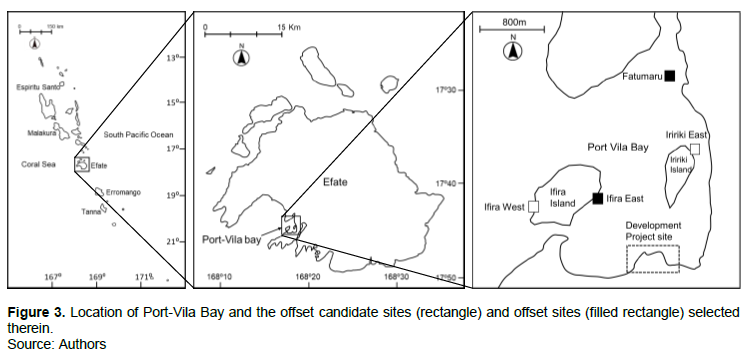
An interview style was used rather than questionnaire surveys, after considering the difficulty of collecting filled-in questionnaire sheets from the respondents due to cultural background and the social circumstances of Vanuatu. Preliminary surveys found that most of the locals used the provisioning and cultural CES in some manner around Port Vila Bay, and that most locals could thus be considered CES users. Therefore, in the main survey, the CES users targeted for the interviews were not specifically pre-identified. Instead, the location where the main CES users of each site live were pre-identified with advice from the executing agency and a census report of Port Vila City (McEvoy et al., 2016). Furthermore, instead of a random sample taken from the entire population of the target site, the locals who were willing to communicate on the interview date and time were interviewed. Similarly, as the study did not employ a purely quantitative approach to prove a hypothesis but adopted a mixed method that combines qualitative and quantitative examination, the sample size was not defined. All interviews were conducted individually without prior notice to avoid response bias resulting from communication among interviewees. The interviewees were Vanuatuans between age of 11 and 79; gender, affiliation, religion, and tribe were not considered.?The details of the interviews are presented in Table 1. The number of responses used for the analysis was less than the actual number of interviewees because no answers were obtained from all interviewees depending on the analysis types.
The questions and answer options used in the main survey are described in Table 2. For most questions, choices were given considering the ease of answering and to avoid unit misunderstandings. Since the preliminary survey identified four CES activities, mainly performed in Port Vila Bay: Fishing, recreation, tourism business, and sand mining, the interviewees were asked about these CES activities in all questions. For the level of engagement in CES activity, the interviewee was asked not only for their original engagement, but also its frequency and duration, as these contribute to our understanding of their dependence on the CES. This assumption, for example, is supported by Salagrama (2006) who emphasizes a clear correlation between the number of working days of fishermen and their food security. For the purpose of the CES activities, recreation and tourism business were clearly conducted for spiritual fulfillment and income generation, respectively. Therefore, data were collected only for fishing and sand mining. In general, sustainable livelihoods could not be achieved from securing food alone, but a cash income was also required. Therefore, if “for selling” was frequently answered, these activities are more likely to contribute to the interviewees’ livelihood. On acceptance of the activity restrictions and continuation status of the CES activities, the reasons were asked but interviewees were not forced to give their answer to avoid disruptions to the social order.
For the necessary conditions required to perform CES activities, the answer options and categories provided are described in Table 3. Since the options provided may be insufficient, "others" was also available to allow a free answer. Among the categories, “substance” reflects the substantive characteristics of provisioning and cultural CES. Therefore, if “substance” is frequently answered, similarities in CES should be considered when selecting alternative sites.
Data processing and analysis
The percentage of each answer was calculated by dividing the number of answers by the total number of answers for each site and/or for each CES activity; except for the reason for the discontinuation as not enough answers were obtained and the inconvenience felt which requires an answer regardless of the site and CES activity. For the level of original engagement in the CES activities, the engagement rate, weighted sum of engagement frequency, and engagement duration were multiplied with each other for each activity to optimize the engagement level. For the inconvenience felt, the frequency of answered option within a category was first divided by the number of answer options, then the percentages of each category were calculated in addition to the calculation of each answer percentage. The percentage of each category was organized for the development project site and for offset sites to propose suitable restoration measures for each of these site categories. Since statistical analysis using a mixture of qualitative and quantitative data is not realistic, each data category was individually organized and the analysis results were comprehensively interpreted with respect to the previously described procedure for a qualitative study introduced by Otani (2017).
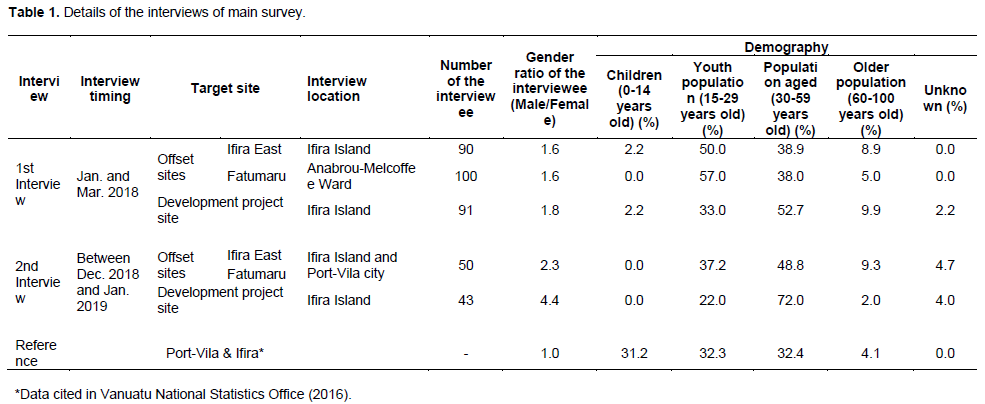
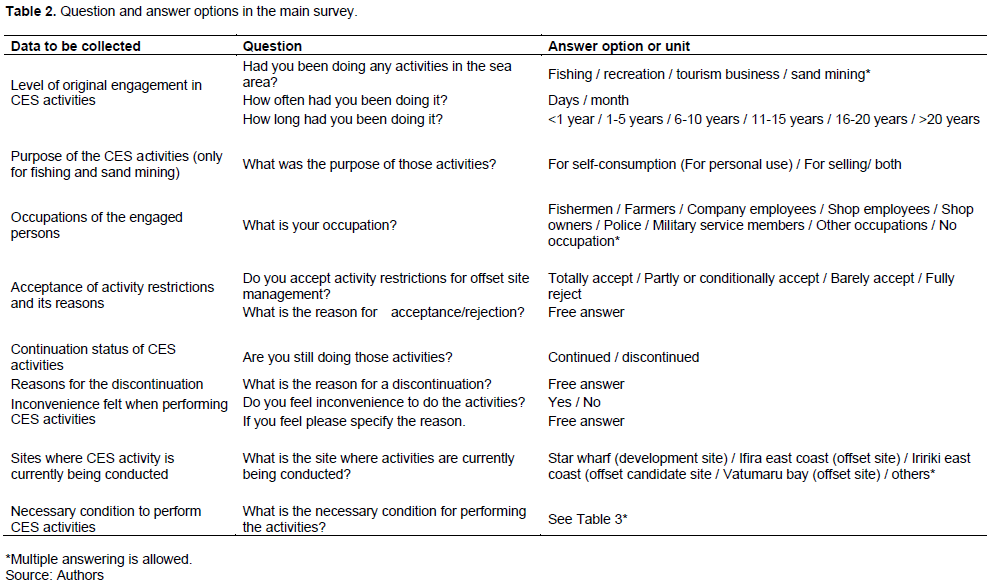
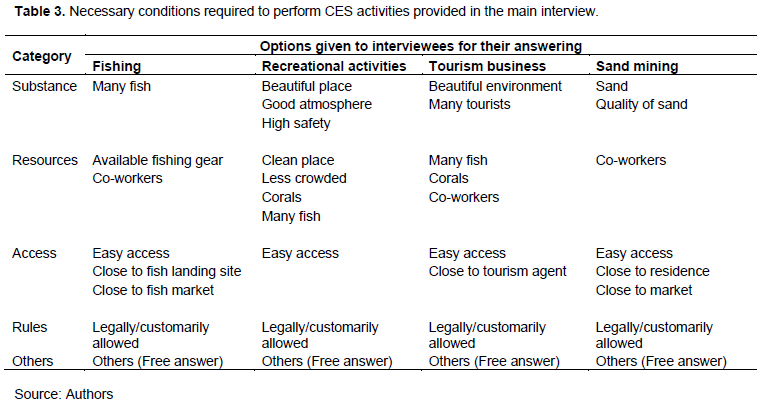
RESULTS
Contributions of the CES uses to livelihoods
The level of original engagement in the CES activities at each site is shown in Figure 4. Fishing consistently showed high engagement levels among the sites, indicating that fishing is a major activity in Port Vila Bay. While there was also a high level of engagement for recreation, its activity levels fluctuated between the sites. For tourism business, engagement was high at Ifira East and the development project site, but extremely low at Fatumaru, while sand mining showed the lowest engagement levels across all sites. Among the CES activities, it is obvious that tourism business is a source of income and that it contributes to people’s livelihood. However, it is uncertain immediately whether fishing contributes to people’s livelihood as they may also fish for recreational purposes. However, recreation plays an important role in the spiritual fulfillment of people (Millennium Ecosystem Assessment, 2003), and therefore, fishing might indirectly contribute to their livelihood. Sand mining is highly likely to contribute to livelihoods as a source of income and as a construction material.
The purposes given for the CES activities are summarized in Figure 5. For fishing, “for self-consumption” is the most prominent purposes while “for selling” was less answered among the sites. However, if including the combined option of “both,” the portion of “for selling” increased at Ifira East and the development project site; therefore, fishing is a main means of livelihood for certain people and at certain sites. For sand mining, more than 90% of the responses were “for personal use,” although the number of responses was low. These results combined with the low level of engagement in sand mining, indicate that it is not a critical CES activity that sustains people’s livelihood.
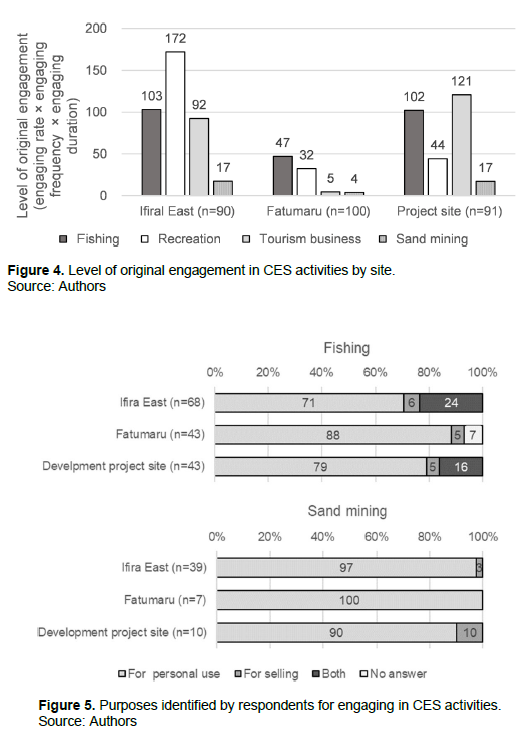
Perception to the restriction of CES uses
The acceptance to the restrictions of CES activities is presented in Figure 6. For fishing, “totally accept” was the highest (62%), however, “partly/conditionally accept” was low (6%); therefore, its total acceptance percentage was less than 70%. In contrast, for recreation and tourism businesses, there were fewer “totally accept” responses (34 and 42%, respectively), but a higher percentage for “partly/conditionally accept” (38 and 32%, respectively); consequently, its total acceptance percentage was more than 70% for each activity. Meanwhile, sand mining obtained moderate “totally accept” (48%) and low “partly/ conditionally accept” (12%) responses; consequently, its total acceptance percentage was the lowest at 60%.
The reasons for acceptance are listed in Table 4. The main reason for full acceptance is concerning the negative environmental impacts of each activity. This means that CES users were interested in resource management. In contrast, the most common reasons for partial or conditional acceptance were to segregate restricted and non-restricted areas, depending on the destructiveness of the activities. According to Takeda et al. (2020), most recreational activities and tourism businesses do not have positive correlations with the mechanical damage of corals, but they do have the potential to cause damage in shallow areas. Thus, if the activities to be restricted could be rationally identified considering the environmental load and if the restricted and non-restricted areas could be segregated as zoning, compensatory measures may not be required for all activities.
Impacts of development projects and offsets on CES uses
The continuation status of CES activities is described in Figure 7. The highest continuation occurred in sand mining (100%), followed by fisheries (71%), tourism business (63%), and then recreation (57%). Since sand mining exhibited a low engagement level and had a low number of respondents, this result may not be plausible. These results infer that certain CES users discontinued their relevant activities. However adverse impacts from the development project and offsetting on the CES uses cannot be predicted from this data alone. Furthermore, only four respondents provided answers for the reasons for discontinuation. One responded that pollution had increased, and the remaining three responded that the development project itself was the reason. It is difficult to hypothesize why pollution increased, but the responses suggest that the development project impacted the continuity of the CES activities to a certain extent.
The inconvenience felt when performing CES activities is shown in Figure 8, and the number of respondents who experienced an inconvenience (33%) was greater than those who did not (21%). Pollution, resource degradation, and marine waste were the major inconveniences felt, as shown in Figure 9. However, other respondents also cited unwelcome rules and regulations and fuel use increases as inconveniences.
These results do not clearly indicate the impact of the development project but suggest that the impacts from construction and new wharf operations may increase environmental degradation and force the original CES uses to move to other areas. The forced movement can also be caused by offsets, suggesting the offset impact on CES uses. However, the degree of offset impact may be less than the development project impact as the offset theoretically does not cause environmental degradation.

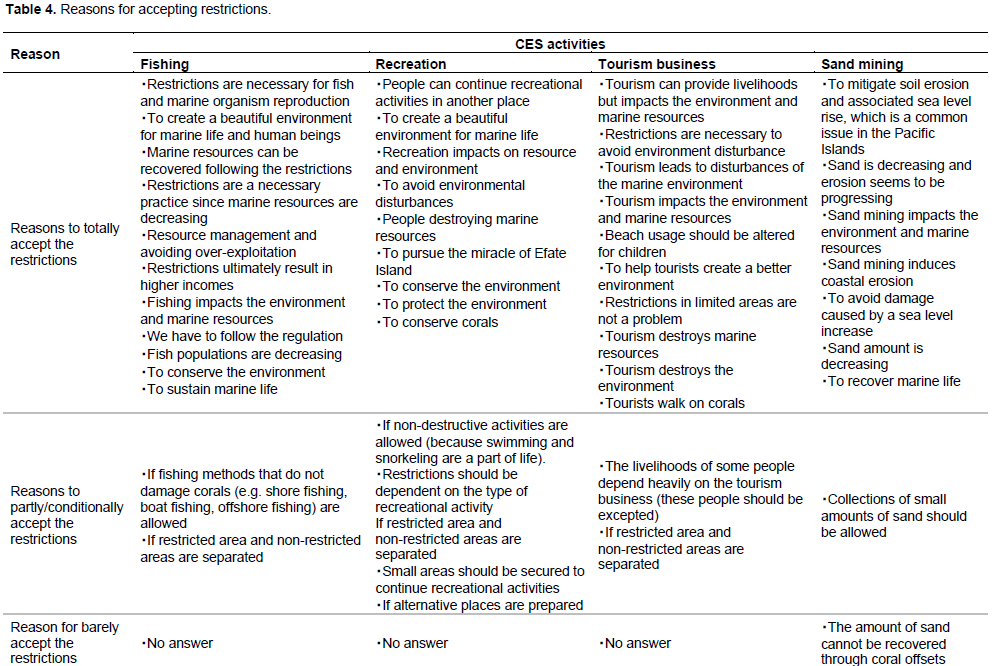

Necessary conditions of the CES activities
The sites that responded, where CES activities are currently being conducted, are summarized in Table 5.
The sites with the most respondents were the development project site (33%), followed by Ifira West (23%), and Ifira East (19%). Ifira East is the closest to the development project site followed by Ifira West. These results indicate that CES users tended to continue their activities at the original location or within its vicinity after construction completion. Notably, recreation and sand mining continued mainly in Ifira West but not at the development project site. In contrast, fishing and tourism businesses continued mainly at and near the development project site, thereby suggesting that fishing and tourism businesses could be continued relatively easily, even during new wharf operations. These results imply that good access could be an important condition for certain CES activities.
Considering the reason for discontinuation and the inconveniences felt, healthy environments are supposedly one of the most important conditions for CES activities. However, since fishing and tourism businesses could continue around the development project site where the environment was degrading, there may be more important conditions to consider, depending on the CES activities.

The responses to the necessary conditions and their categories are illustrated in Figures 10 and 11, respectively. It is obvious that many responses belong to the substantive condition that reflects the CES (Figure 11). This means that many CES users are aware of the substantial characteristics of the CES when performing their activities; for example, “Many fish” was the most frequent answer for fishing. Consequently, an area that accommodates many fishes should be selected as an alternative site for fishing. Furthermore, for recreation in the offset sites, “easy access” would be required, based on the responses. This is possibly because recreation often requires frequent traveling. Additionally, rules are also a necessary condition especially for recreation and sand mining. This may explain why recreation and sand mining mainly continued outside of the development project site (Table 4), specifically because of new rules formulated for wharf operations.
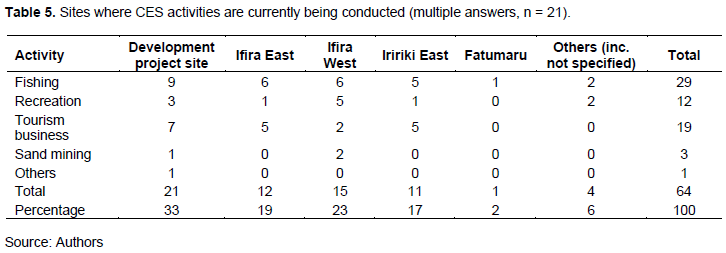
Consideration of restoration measures
The necessity of compensation and the restoration measures are shown in Table 6. Fishing is a prominent CES activity among the sites. Higher dependence on the living marine resources and higher engagement in fishing around Port Vila City was also previously reported by Trundle and McEvoy (2015). As reasons for the discontinuation and the inconvenience, environmental degradation supposedly induced by the development project was often the response. These responses indicate that the necessity of compensation is high. However, fishing is not a major means of income generation. Additionally, the interviewees tended to accept fishing restrictions to enable resource management. From these, the necessity of compensation can be evaluated as moderated for the development project site. While the necessity is low for the offset sites because offsetting theologically does not cause environmental degradation and an increase in the abundance of fish can be expected due to the offset’s conservation effect. The most important condition for fishing is fish abundance, and the current major fishing sites are the development project site and Ifira West, which suggests that fish are abundant at these sites. Therefore, the following restoration measures were suggested: (1) An alternative fishing site should be designated at the development project site but rules for safety and the prevention of marine pollution should also be installed; (2) An alternative fishing ground should also be designated at Ifira West, but measures such as the installation of a floating pier and an information board citing the environmental rules are desirable to avoid further coral damage.
The level of engagement in recreation was high at Ifira East and Fatumaru. However, a certain number of interviewees discontinued the recreation and/or found inconveniences to enjoy them, after the construction was completed. Furthermore, many interviewees suggested restriction/no restriction zoning for specific recreational activities as a condition of the recreation restrictions. In general, recreation keeps people mentally healthy. Considering these points, the necessity of compensation is high for Ifira East and Fatumaru users. For the restoration measure option, good access was found to be a key. Therefore, alternative sites should be designated in the vicinity of the original sites. To avoid further mechanical damage to the corals via trampling, alternative sites should be located at a sandy beach or should have a certain depth. Some sandy areas with patchy coral colonies between Ifira Island and the development project site, as well as the adjacent coastal area of Fatumaru, are appropriate as they are both located proximally to the original sites. To ensure that further coral damage is avoided measures should be taken, such as installing a floating pier and an information board to cite the environmental rules.
Tourism businesses contribute to people’s livelihood, and engagement in them was high at Ifira East and development project site. In addition, a certain number of interviewees reported that they discontinued their businesses and/or experienced inconvenience to perform their business due to the development projects. Furthermore, many interviewees suggested restriction/no restriction zoning for specific tourism as a condition of the tourism restrictions. Considering these points, the necessity of compensation is high for Ifira East and project sites users. The most frequently identified condition for a tourism business was “a beautiful environment”, followed by “many tourists.” Moreover, the development project site was the most frequently identified location for current tourism businesses, followed by Ifira East and Iririki East. This infers that local people gather tourists at the new wharf and take them to surrounding sites to let them enjoy the beautiful landscape. The demand for tourism business will increase with the operation of the new wharf, and consequently, the development project site should be designated as an alternative site for gathering tourists. Instead of Ifira East (an offset site), Iririki West which has beautiful sandy beaches should be suggested as the alternative site for tourists. However, tourism has the potential of causing coral degradation. Therefore, the installation of a floating pier and the establishment of rules such as ban on standing and trampling on the corals should be undertaken.
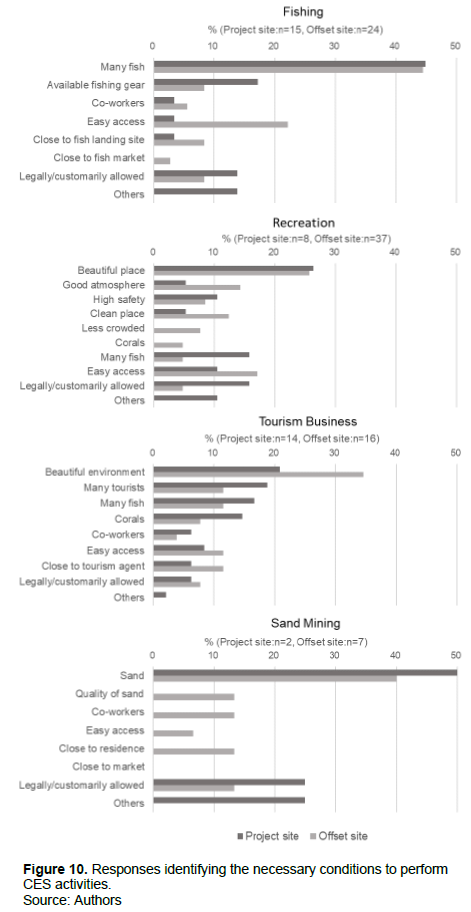
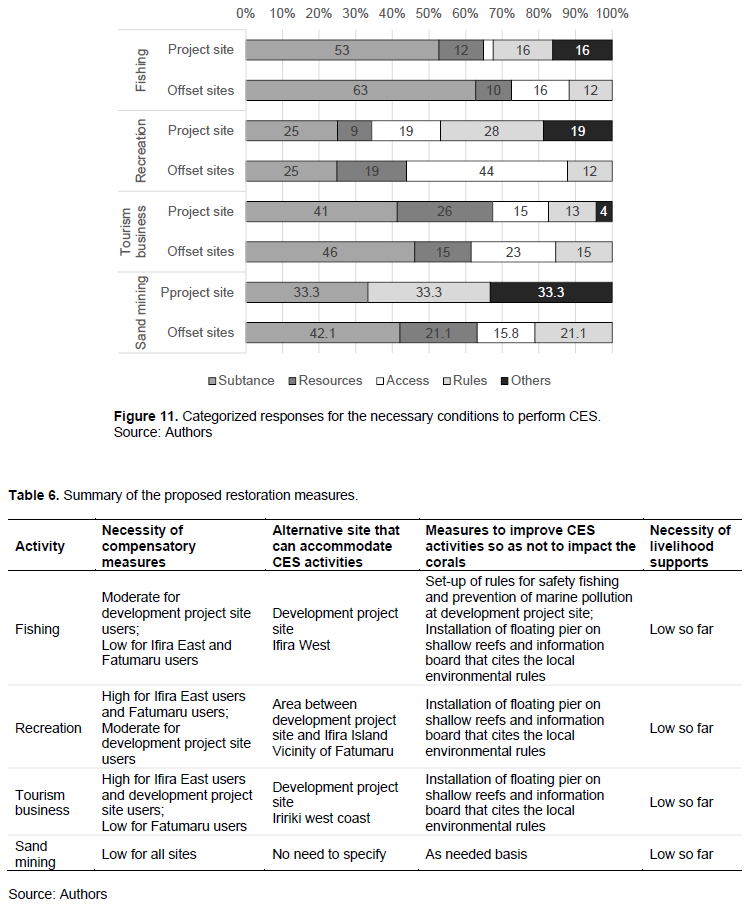
DISCUSSION
Advantages and disadvantages of the framework
Offsetting could have potential conservation effects. In addition, through the continuation of CES activities at multiple alternative sites with minimum inconvenience and reduced environmental load, it may be possible to minimize the concentration of CES uses and consequent conflict, and eventually balancing between conservation and use theoretically can be achieved. However, to confirm such outcomes for the framework, time series change for the CES uses and the coral state should be monitored for certain periods after the enforcement of relevant laws and regulations. Of course, the cooperation of stakeholders is essential. In this context, the framework is incomplete. The framework only proposed reasonable alternative sites and improvements of the CES uses, and did not confirm the adequacy of those measures.
In Port Vila Bay, Takeda et al. (2020) previously found a positive correlation between some CES uses and coral damage. For example, line fishing and spear fishing were correlated with mechanical coral damage, which may be caused by walking and/or standing in a shallow area (Takeda et al., 2020). These fishing methods are common in some communities around Port Vila Bay (McEvoy et al., 2016). In this context, measures proposed through the framework, such as the dispersion of alternative sites, awareness creation, and the installation of floating piers, could help to avoid further coral degradation while maintaining CES uses, and are therefore advantageous. The framework revealed that the social situation and changes necessary to propose compensation measures, such as contribution of the CES uses to livelihoods, perceptions of the CES use restrictions, conditions of CES uses and, actual adverse impacts of the development project and offsetting, all varied from site to site, even within a relatively small area. This helped to screen and prioritize the CES uses that require compensation and consequently enabled us to suggest alternative sites and improvements for CES uses. However, donor’s safeguard policies also stipulate the consideration of social situations and changes through baseline socioeconomic studies and consultations with locals, to ensure the project’s risks (e.g., The World Bank, 2016). This means that this idea of the framework is not new.
The framework is unique in that the CES, which are difficult to quantify, are rationally considered for both the development project and offsetting and it can suggest restoration measures per CES uses by considering the characteristics of the original location and use style. For example, the framework indicated that fishing at the development project site was impacted by environmental degradation but continued after construction completion. In contrast, fishing at an offset site may not be largely impacted by degradation. Eventually, the continuation of fishing at the development project site while setting rules for fishing safety and for the prevention of marine pollution was proposed, having found that the development project site has a higher abundance of fish.
It is notable that the applied project was in the implementation stage and this situation made it possible to evaluate the actual impacts; some locals were forced to use CESs elsewhere, felt they were inconvenient to use, or even forced to stop their use altogether. Such implementation stage cases may still fail to evaluate the actual impacts unless monitoring data is available. This means that the framework can be conditionally used.
A way forward for the sustainable use of coral ecosystems
In the same offset case for Vanuatu, the offset sites that have a high restorability, lower human dependency on CES, and good accessibility were officially selected, and the CES activities to be restricted at the offset sites were announced before this investigation to mitigate the social impacts of development and offsetting. However, these measures lacked solutions to manage further social issues, that is, the remaining losses and additional losses of CES uses had to be addressed. To respond to this issue, this investigation has identified suitable alternative sites and improvements of CES uses as a compensation measure.
To manage PAs effectively and functionally, management regimes should respond to the goals of local communities (McClanahan, 2006). For Vanuatu, the offset sites will be internalized within the CCA that the local community is trying to establish for the purpose of resource management. Although this localized situation is not applicable for all offsetting cases, aligning offsetting with community-based resource management activities is nonetheless beneficial. Thus, by using optimum offset site selection, restrictions of the destructive CES uses, provision of alternative sites for the uses, and the improvement of the uses and integrating existing community-based resource management schemes, offsetting became a more realistic strategy by which to achieve the sustainable use of endangered coral ecosystems. However, to ensure the function of the framework, the social and environmental changes should be continuously monitored in a participatory manner respecting community initiatives and with financial and technical support of relevant authorities after taking these measures in the offset case of Vanuatu.
CONCLUSION
Although development projects can benefit nations, the deterioration of ecosystems associated with these projects can negatively impact local livelihoods. This paper suggested a framework by which to examine how these social impacts can efficiently be compensated in offsetting practices. By applying the framework to an actual coral offsetting case, it was found that there is not always a high necessity level for compensation and those suitable alternative sites to restore CES activities can differ depending on the original location of the CES activities. Furthermore, the framework enabled us to propose improvements of the CES use to reduce environmental degradation while maintaining the benefits of the use at alternative sites. Even though offsetting itself has the potential to conserve degraded ecosystems, it was also expected that these findings will facilitate the sustainable uses of coral ecosystems, which are increasingly threatened. However, to ensure the function of this framework further social and coral monitoring are required.
ACKNOWLEDGMENTS
The authors express their thanks to all staff members at the Vanuatu Project Management Unit, the executing agency of the wharf development project for their support during the interviews. The authors also extend their thanks to staff members at the Department of Environment Protection and Conservation for their information about Community Conservation Area.
CONFLICT OF INTERESTS
No potential conflict of interest was reported by the authors. Though the study cited throughout this work was planned as part of PhD studies undertaken by the lead author, the interviews were conducted by the Japan International Cooperation Agency (JICA), a donor agency of the wharf development project. Therefore, all data shown in this paper were provided by JICA. The views expressed in this paper, however, are those of the authors alone and do not reflect the official view of JICA. The author did not receive any specific grants from funding agencies in the public, commercial, or not-for-profit sectors.
REFERENCES
|
Agar J, Shivlani M, Fleming C, Solís D (2019). Small-scale fishers' perceptions about the performance of seasonal closures in the commonwealth of Puerto Rico. Ocean and Coastal Management 175:33-42. |
|
|
Barton JA, Willis BL, Hutson KS (2015). Coral propagation: a review of techinques for ornamental trade and reef restoration. Reviews in Aquaculture 9: 238-256. |
|
|
Bayraktarov E, Saunders M, Abdullah S, Mills M, Beher J, Possingham HP, Mumby PJ, Lovelock CE (2016). The cost and feasibility of marine coastal restoration. Ecological Applications 26(4):1055-1074. |
|
|
Business and Biodiversity Offsets Programme (BBOP) (2012). Biodiversity offset design handbook-updated. Washington, D.C.: BBOP. |
|
|
Benabou S (2014). Making Up for Lost Nature? A Critical Review of the International Development of Voluntary Biodiversity Offsets. Environment and Society 5(1):103-123. |
|
|
Bidaud C, Schreckenberg K, Rabeharison M, Ranjatson P, Gibbons J, Jones JG (2017). The sweet and the bitter: intertwined positive and negative social impacts of a biodiversity offset. Conservation and Society 15(1):1. |
|
|
Birkeland C (1997). Life and death of coral reefs. Chapman and Hall, New York. |
|
|
Bull JW, Suttle KB, Gordon A, Singh NJ, Milner-Gulland EJ (2013). Biodiversity offsets in theory and practice. Oryx 47(3):369-380. |
|
|
Bullock JM, Aronson J, Newton AC, Pywell RF, Rey-Benayas JM (2011). Restoration of ecosystem services and biodiversity: Conflicts and opportunities. Trends in Ecology and Evolution 26(10):541-549. |
|
|
Calvet C, Napoléone C, Salles JM (2015). The biodiversity offsetting dilemma: Between economic rationales and ecological dynamics. Sustainability (Switzerland) 7(6):7357-7378. |
|
|
Cesar H, Burke l, Pet-Soede l (2003). The economics of worldwide coral reef degradation. Arnhem, Netherlands: Cesar Environmental Economics Consulting. |
|
|
Edgar G, Stuart-Smith RD, Willis TJ, Kininmonth S, Baker SC, Banks S, Barrett NS, Becerro MA, Bernard ATF, Berkhout J, Buxton CD, Campbell SJ, Cooper AT, Davey M, Edgar SC, Försterra G, Galván DE, Irigoyen AJ, Kushner DJ, Moura R, Parnell PE, Shears NT, Soler G, Strain EMA, Thomson RJ (2014). Global conservation outcomes depend on marine protected areas with five key features. Nature 506(7487):216-220. |
|
|
Edwards AJ, Gomez ED (2007). Reef Restoration and remediation guidelines: Making sensible management choices in the face of uncertainty. St Lucia, Australia: Coral Reef Targeted Research & Capacity Building for Management Programme, iv-38. |
|
|
Gomez ED (1997). Reef management in developing countries: A case study in the Philippines. Coral Reefs 16:S3-S8. |
|
|
Grimm M, Köppel J (2019). Biodiversity Offset Program Design and Implementation. Sustainability 11:6903. |
|
|
Hein MY, Willis BL, Beeden R, Birtles A (2017). The need for broader ecological and socioeconomic tools to evaluate the effectiveness of coral restoration programs. Restoration Ecology 25(6):873-883. |
|
|
Honrado JP, Vieira C. Soares C, Monteiro MB, Marcos B, Pereira HM, Partidário MR (2013). Can we infer about ecosystem services from EIA and SEA practice? A framework for analysis and examples from Portugal. Environmental Impact Assessment Review 40(1):14-24. |
|
|
Ireland C (2004). Alternative sustainable livelihoods for coastal communities - A review of experience and guide to best practice. Somerset: The IDL Group/IUCN. |
|
|
Jacob C, Vaissiere AC, Bas A, Calvet C (2016). Investigating the inclusion of ecosystem service in biodiversity offsetting. Ecosystem Service 21:92-102. |
|
|
Jacob C, Buffard A, Pioch S, Thorin S (2018). Marine ecosystem restoration and biodiversity offset. Ecological Engineering 120:585-594. |
|
|
Jacob C, van Bochove JW, Livingstone S, White T, Pilgrim J, Bennun L (2020). Marine biodiversity offsets: Pragmatic approaches toward better conservation outcomes. Conservation Letters 13(3):e12711. |
|
|
Jossefson J, Widenfalk LA, Blicharska M, Hedblom M, Pärt T, Ranius T, Öckinger E (2021). Compensating for lost nature values through biodiversity offsetting - Where is the evidence? Biological Conservation 257:109117. |
|
|
Kelleher G (1999). Guidelines for Marine Protected Areas. Switzerland and Cambridge, UK: IUCN Gland xxiv-107. |
|
|
Ledec GC, Johnson SDR (2016). Biodiversity o?sets: A user guide. Washington, D.C. World Bank Group. |
|
|
Lester SE, Halpern BS, Grorud-Colvert K, Lubchenco J, Ruttenberg BI, Gaines SD, Airamé S, Warner RR (2009). Biological effects within no-take marine reserves: A global synthesis. Marine Ecology Progress Series 384:33-46. |
|
|
Leverington F, Costa KL, Pavese H, Lisie A, Hockings M (2010). A global analysis of protected area management effectiveness. Environmental Management 46:685-698. |
|
|
Lowe J, Friedrich J, Tejada C, Meekan MG (2019). Linking livelihoods to improved biodiversity conservation through sustainable integrated coastal management and community based dive tourism: Oslob Whale Sharks. Marine Policy 108:103630. |
|
|
Maron M, Hobbs RJ, Moilanen A, Matthews J, Christie K, Gardner TA, Keith DA, Lindenmayer DB, McAlpine CA (2012). Faustian bargains? Restoration realities in the context of biodiversity offset policies. Biological Conservation 155:141-148. |
|
|
Maron M, Ives CD, Kujala H, Bull JW, Maseyk FJF, Bekessy S, Gordon A, Watson JEM, Lentini PE, Gibbons P, Possingham HP, Hobbs RJ, Keith DA, Wintle BA, Evans MC (2016). Taming a wicked problem: Resolving controversies in biodiversity offsetting. BioScience 66(6):489-498. |
|
|
McClanahan TR, Marnane MJ, Cinner JE, Kiene WE (2006). A comparison of marine protected areas and alternative approaches to coral-reef management. Current Biology 16(14):1408-1413. |
|
|
McEvoy D, Ville Nd, Komugabe-Dixson A, Trundle A (2016). Greater Port Vila: Ecosystem and socio-economic resilience analysis and mapping (ESRAM): Technical summary. Melbourne, Australia: RMIT University. |
|
|
Millennium Ecosystem Assessment (2003). Ecosystems and human well-being: a framework for assessment. Washington, D.C.: World Resources Institute. |
|
|
Moberg F, Rönnäback P (2003). Ecosystem services of the tropical seascape: Interactions, substitutions and restoration. Ocean & Coastal Management 46(1-2):27-46. |
|
|
Moreno-Mateos D, Maris V, Béchet A, Curran M (2015). The true loss caused by biodiversity offsets. Biological Conservation 192:552-559. |
|
|
Munthali S, Mughogho D (1992). Economic incentives for conservation: Beekeeping and saturniidae caterpillar utilization by rural communities. Biodiversity Conservation 1:142-154. |
|
|
Niner HJ, Milligan B, Jones PJS, Styan CA (2017). A global snapshot of marine biodiversity offsetting policy. Marine Policy 81:368-374. |
|
|
Otani T (2017). What is qualitative research? Yakugaku Zasshi 137(6):653-658. |
|
|
Precht WE, Aronson RB, Miller SL, Keller BD, Causey B (2005). The folly of coral restoration programs following natural disturbances in the Florida Keys National Marine Sanctuary. Ecological Restoration 23:1. |
|
|
Roe D, Booker F, Day M, Zhou W, Allebone?Webb S, Hill NAO, Kumpel N, Petrokofsky G, Redford K, Russell D, Shepherd G, Wright J, Sunderland TCH (2017). Are alternative livelihood projects effective at reducing local threats to specified elements of biodiversity and / or improving or maintaining the conservation status of those elements? Environmental Evidence 4:22. |
|
|
Salagrama V (2006). Trends in poverty and livelihoods in coastal ?shing communities of Orissa State, India. FAO Fisheries Technical Paper No. 490, FAO, Rome. |
|
|
Sievanen L, Crawford B, Pollnac R, Lowe C (2005). Weeding through assumptions of livelihood approaches in ICM: Seaweed farming in the Philippines and Indonesia. Ocean & Coast Management 48(3-6):297-313. |
|
|
Sonter L, Gordon A, Archibald C, Simmonds, JS. Ward M, Metzger JP, Rhodes JR, Maron M (2020). Offsetting impacts of development on biodiversity and ecosystem services. Ambio. 49:892-902. |
|
|
Souza BA, Rosa JCS, Siqueira-Gay J, Sánchez LE (2021). Mitigating impacts on ecosystem services requires more than biodiversity offsets. Land Use Policy 105:105393. |
|
|
Takeda S, Murayama T, Nishikizawa S, Nagaoka A (2020). Mitigation of coral ecosystem service-related social issues: evidence from a coastal development project in a developing country. Impact Assessment and Project Appraisal 39 (1):36-50. |
|
|
Triet R (2010). Combining biodiversity conservation with poverty alleviation-a case study in the Mekong Delta Vietnam. Aquatic Ecosystem Health Management 13:41-46. |
|
|
Trundle A, McEvoy D (2015). Port Vila Climate Vulnerability Assessment - Abridged Report. (Pre TC Pam report and statistics). UN Habitat and RMIT University. |
|
|
Wicander S, Coad L (2018). Can the provision of alternative livelihoods reduce the impact of wild meat hunting in West and Central Africa? Conservation and Society 16(4): 441-458. |
|
|
Wilkinson C (2008). Status of coral reefs of the world: 2008. Townsville, Australia: Global Coral Reef Monitoring Network and Reef and Rainforest Research Centre 296 p. |
|
|
Wright JH, Hill NAO, Roe D, Rowcliffe JM, Kümpel NF, Day M, Booker F, Milner-Gulland EJ (2015). Reframing the concept of alternative livelihoods. Conservation Biology 30(1):7-13. |
|
|
The World Bank (2016). World Bank Environmental and Social Framework. Washington (D.C.): The World Bank pp. 53-64. Available from: |
|
|
Yeemin T, Sutthacheep M, Pettongma R (2006). Coral reef restoration projects in Thailand. Ocean & Coastal Management 49(9-10):562-575. |
|
Copyright © 2024 Author(s) retain the copyright of this article.
This article is published under the terms of the Creative Commons Attribution License 4.0